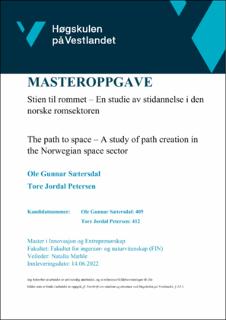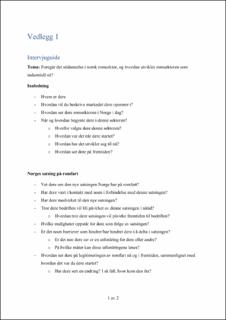| dc.contributor.author | Petersen, Tore Jordal | |
| dc.contributor.author | Sætersdal, Ole Gunnar | |
| dc.date.accessioned | 2022-09-13T08:33:01Z | |
| dc.date.available | 2022-09-13T08:33:01Z | |
| dc.date.issued | 2022 | |
| dc.identifier.uri | https://hdl.handle.net/11250/3017418 | |
| dc.description | Masteroppgave i innovasjon og entrepenørskap.
Fakultet for ingeniør- og naturvitskap/ Mohnsenteret for innovasjon og regional utvikling/ Høgskulen på Vestlandet, campus Bergen. | en_US |
| dc.description.abstract | Norge har vært en romnasjon siden 60-tallet, og skjøt opp sin første forskningsrakett bare fem
år etter at Sovjetunionen plasserte Sputnik i bane rundt jorda. Selv om Norge har deltatt lenge
i romsektoren, er det først i de senere tider at industrien har begynt å få legitimitet, selv om
mye ennå gjenstår for at befolkningen i Norge skal se på seg selv som en romnasjon på lik
linje med en oljenasjon. De senere årene har det kommet en ny driv i romsektoren. Staten har
gjennom stortingsmelding 10 (2019-2020) varslet at de skal satse på romfart, og de har
bevilget penger til å bygge en oppskytningsbase for småsatellitter på Andøya. Aktørene som
jobber i romsektoren, har samarbeidet med hverandre og med staten for å få til dette.
Stidannelse er et fenomen som kan anvendes på mange ulike måter, og i denne oppgaven har
vi valgt å fokusere på regional stidannelse i to regioner i Norge. Regional stidannelse er en
prosess med ulike steg og mekanismer. Vi har utforsket hvordan stidannelsesprosessen ser ut
i romsektoren og hvilke mekanismer for stidannelse som er til stede, samt hvilken fase
romsektoren befinner seg i. En stidannelsesprosess består av institusjonelle miljøer,
nøkkelaktører, markedskonstruksjon, regionale og ekstraregionale ressurser og
stidannelsesmekanismer med en tilkobling til GPN. Samhandlingen mellom disse elementene
gir moment og retning for en industriell sti til å utvikle seg. I tillegg har litteratur om faser
innen industrielle stier og institusjonelle aktører og stidannelse blitt brukt for å supplere
litteraturen om stidannelsesprosesser. En industriell sti kan befinne seg i ulike faser;
preformasjonsfase, stidannelsesfase eller stiutviklingsfase, og vi har undersøkt hvilken fase
romindustrien i Norge befinner seg i. Institusjonelle aktører og stidannelseslitteraturen gir et
større innblikk i utvekslingen mellom nøkkelaktører og institusjonelle miljøer igjennom topptil-
bunn og bunn-til-topp perspektiver.
Det ble funnet at aktørene i romsektoren samarbeider med hverandre, både bedrifter, ikkebedrifter,
institusjonelle aktører og internasjonale aktører. Det er også et marked for både
oppstrøms- og nedstrømssegmentet, og både regionale og ekstraregionale ressurser tas i bruk
for å bygge opp industrien. Romsektoren preges av både stidannelse og stiutvikling, og den er
i stadig vekst. Stiutviklingen som utarter seg i regionene til studiet bærer preg av samarbeid
med hverandre og et bunn – topp perspektiv kan vise å ha lagt grunnlaget for momentet bak
stortingsmelding 10. | en_US |
| dc.description.abstract | Norway has been a space nation since the 1960s and launched its first research rocket just
five years after the Soviet Union placed Sputnik in orbit around the earth. Although Norway
has participated for a long time in the space sector, it is only in recent times that the industry
has begun to gain legitimacy, although much remains for the people of Norway to see
themselves as a space nation on an equal footing as an oil nation. In recent years, there has
been a new drive in the space sector. Through a report from the Norwegian parliament
(stortingsmelding 10 (2019-2020)), the state has announced that they will invest in the space
sector, and they have allocated money to build a launch base for small satellites on Andøya.
The actors working in the space sector have collaborated with each other and with the state to
achieve this.
Path creation is a phenomenon that can be applied in many ways, and in this thesis, we have
chosen to focus on regional path creation in two regions in Norway. Regional path creation is
a process with different steps and mechanisms. We have explored what the path creation
process looks like in the space sector and what mechanisms for path creation are present, as
well as what phase the space sector is in. A path creation process consists of institutional
environments, key actors, market construction, regional and exstraregional resources and path
formation mechanisms with connection to GPN. The interaction between these elements
provides momentum and direction for an industrial path to develop. In addition, literature on
phases within industrial paths and institutional actors and path formation has been used to
supplement the literature on path formation processes. An industrial path can be in different
phases; preformation phase, path creation phase or path development phase, and we have
investigated which phase the space industry in Norway is in. Institutional actors and path
formation literature provide a greater insight into the exchange between key actors and
institutional environments through top-to-bottom and bottom-to-top perspectives.
It was found that the actors in the space industry sectors cooperate with each other, both
firmes, non-firms, institutional actors and international actors. There is a market for both the
upstream and downstream segments, and both regional and extraregional resources are used
to build up the industry. The space sector is characterized by both path formation and path
development, and it is constantly growing. The path development in the regions of the study
bears a mark of cooperation with each other and a bottom-up perspective may show that it has formed the basis for the moment behind the report from the parliament (stortingsmelding
10). | en_US |
| dc.language.iso | nob | en_US |
| dc.publisher | Høgskulen på Vestlandet | en_US |
| dc.rights | Navngivelse 4.0 Internasjonal | * |
| dc.rights.uri | http://creativecommons.org/licenses/by/4.0/deed.no | * |
| dc.title | Stien til rommet – En studie av stidannelse i den norske romsektoren | en_US |
| dc.title.alternative | The path to space – A study of path creation in the Norwegian space sector | en_US |
| dc.type | Master thesis | en_US |
| dc.description.localcode | INN599 | en_US |


